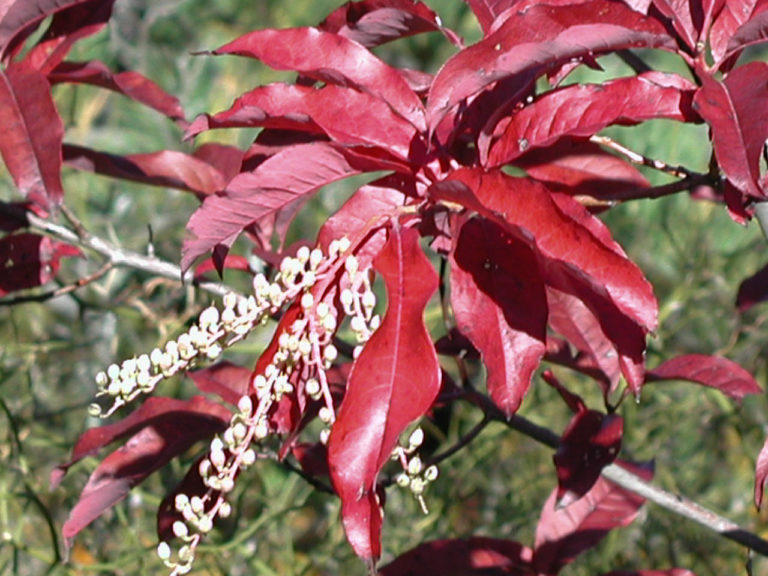Sourwood is a small to medium (30-70’) deciduous, understory tree found throughout the Carolinas in mixed hardwood forests It is the only member of its genus (Oxydendrum) and has no known subspecies, varieties or forms. It is in the Ericaceae family, and its closest relatives are in the genera Pieris and Lyonia. Sourwood is beloved for several reasons. When grown in the open as a specimen, it will develop a conical or rounded crown, but in an understory situation it tends to be vertical or contorted, chasing the dapples of the sun, and will have less branching. The bark of mature specimens is distinctive, being deeply furrowed and ridged. Leaves are lustrous and shining. It flowers spectacularly in the early summer, with graceful racemes of white flowers that hang in sprays about 6″ long against the deep green foliage. As if that were not enough, the foliage of the Sourwood turns all shades of red (rich maroon, scarlet or plum color) which persist late into autumn in the fall. The rich colors form a backdrop to the beautiful, persistent seed structures — a reversal of the color pattern seen in the spring. Finally, it is a wonderful plant for attracting pollinators, and the honey made from Sourwood flowers is highly prized as one of the premium honeys of the world.
NURSERY HOURS
Wednesday: 10-4 Thursday: 10-6 Friday-Saturday: 10-4 Sunday: 12-4
Oxydendrum arboreum

Key Info
Scientific Name: Oxydendrum arboreum (L.) DC.
Common Names: Sourwood, Sorrel Tree, Lily of the Valley Tree, Titi Tree, Arrowwood, Elk Tree, Sorrel Gum, Sour Gum, and Tree Andromeda.
Family Names: Ericaceae
Plant Type: Tree / Shrub
Leaf Retention: Deciduous
Flower Color: White
Special Characteristics: Showy fruit, Flowers fragrant, Attracts bees, Good fall color, Nectar plant, Reported to be deer resistant (moderately)
Additional Info
Habit: Sourwood is a short lived, woody perennial tree with a slender (often crooked and leaning) trunk, and a narrow to oval-shaped, irregular crown with relatively dense foliage. Its form is more pyramidal with branching to the ground if grown in the open. Trunk diameter averages 14-16 inches. The bark is grayish brown with deep furrows and often the furrows are broken into recognizable rectangles resulting in a blocky, alligator-hide texture similar to persimmon. There is a juvenile taproot which is soon replaced by a developing fibrous, shallow root system of the mature tree.
Height: 40'-60' (in the wild)25' to 30' (cultivated specimens)
Spread: 25' - 30'
Soil Conditions: Moist, organically rich, well-drained soils; acidic; clay; loam; sand;
Leaves: Alternate or spirally arranged, simple, glossy dark green leaves 4-8” long and 1½ to 3½ inches wide; elliptical to lanceolate in shape with distinctly pointed tips; margins may be finely-toothed and wavy, the leaf base wedge-shaped. The lower leaf surface is paler green than the upper, with slight pubescence on the mid-vein below. A sour taste of the leaves is a diagnostic character. It vies with Blackgum for intensity of foliage color in the fall.
Flowers (or reproductive structures: Sourwood is monoecious. Numerous small, perfect flowers are held on one side of long, sweeping or drooping sprays (racemes). These showy sprays are 5½ - 10 inches long and terminal on the branches, appearing midsummer, after the leaves are fully grown. Individual sourwood flowers are small, urn-shaped, fragrant, with white to creamy-white colored petals, waxy,~¼ inche long.
Fruit: The flowers give way to 5-parted dry, oval, silver grey, dehiscent capsules about 1/2 to 1/3 inch long that ripen in September. The capsules continually release very tiny, 2-winged seeds into winter, remaining attached to the tree. The capsules are individually inconspicuous but arranged in attractive sprays which stand out against the colorful fall foliage.
Natural Distribution: Sourwood is found in the understory and midstory of several different forest types. They are common but scattered in open mixed hardwood forests on rocky slopes and in coves, clearings, and well drained woodlands of bluffs, and are an especially characteristic understory tree of upland forests of the piedmont and lower mountains.
USDA Hardiness Zone: 5 to 9
USDA Wetland Indicator Status in NC: UPL (FACU on costal plane)
Pollination: Flowers are insect pollinated, primarily by bees,
Wildlife Connections: There are few references on how animals make use of sourwood. It is browsed by deer, especially the young shoots. But the small seed capsules are not usually mentioned as providing wildlife food. The greatest use of sourwood seems to be by bees which generate the coveted sourwood honey. Several butterflies and moths are documented as foliage feeders, as well as the fall webworm at lower elevations. The largest sourwoods are cited as providing small cavities for animal nesting or roosting (reptiles, amphibians, bats).
Propagation: By seeds or by softwood cuttings.
